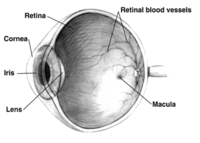
Photo from wikipedia
Purpose To investigate age-related changes of the outer nuclear layer (ONL) thickness and cone density, and their associations in healthy participants using a modified, narrow scan-angle Heidelberg Retina Angiograph (HRA2).… Click to show full abstract
Purpose To investigate age-related changes of the outer nuclear layer (ONL) thickness and cone density, and their associations in healthy participants using a modified, narrow scan-angle Heidelberg Retina Angiograph (HRA2). Methods Retinal cones were imaged outside the fovea at 8.8° eccentricity and cone density was compared to ONL thickness measurements obtained by Spectral-Domain Optical Coherence Tomography (SD-OCT) at the same locations. Fifty-six eyes of 56 healthy participants with a median age (interquartile range, IQR) of 37 years (29–55) were included. Results Median (IQR) cone count was 7,472 (7,188, 7,746) cones/mm2 and median (IQR) ONL thickness was 56 (52, 60) µm for healthy participants. Both cone density and ONL thickness were negatively associated with age: cone density, R2 = 0.16 (F(1,54) = 10.41, P = 0.002); ONL thickness, R2 = 0.12 (F(1,54) = 7.41, P = 0.009). No significant association was seen between cone density and ONL thickness (R2 = 0.03; F(1,54) = 1.66, P = 0.20). Conclusion Cone density was lower, and ONL thinner, in older compared to younger participants, therefore, image-based structural measures should be compared to age-related data. However, cone density and ONL thickness were not strongly associated, indicating that determinants of ONL thickness measurements other than cone density measurements, and including measurement error, have a major influence.
Journal Title: European Journal of Ophthalmology
Year Published: 2023
Link to full text (if available)
Share on Social Media: Sign Up to like & get
recommendations!